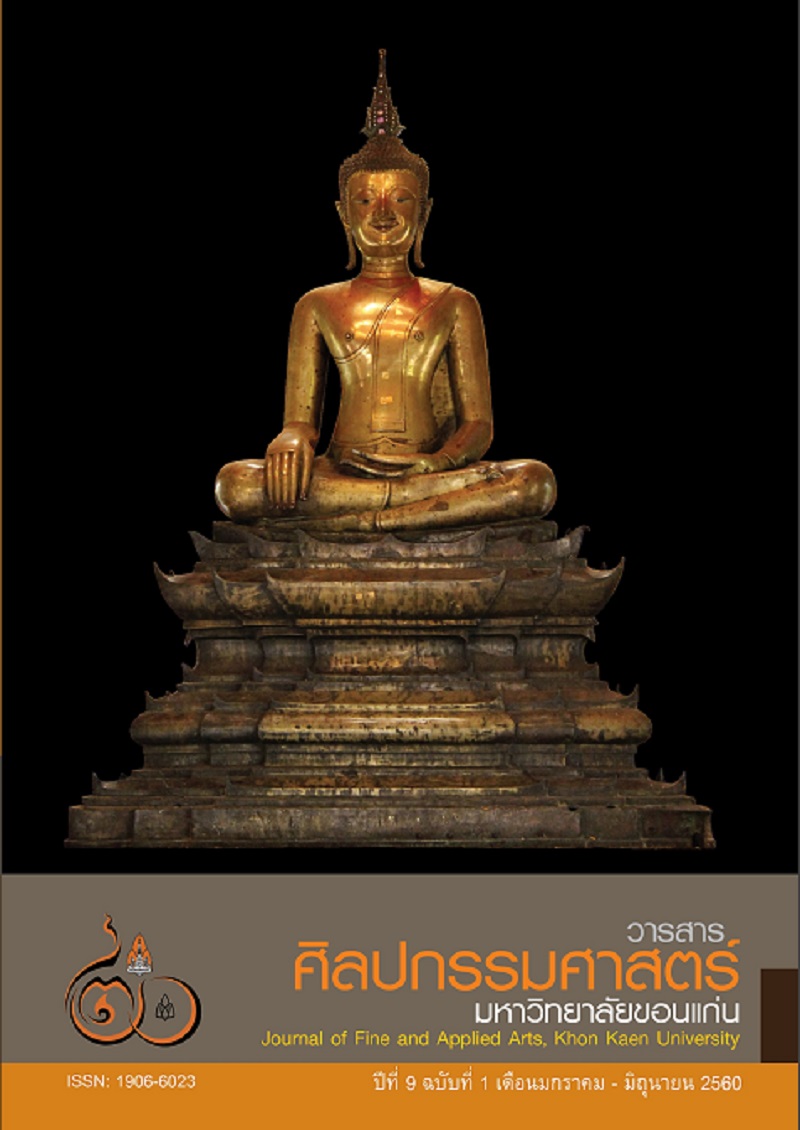การสร้างสรรค์ลายพิณของครูบุญมา เขาวง The Creation of the Pin Playing Style by Khru Boonma Khaowong
Main Article Content
Abstract
งานวิจัยเรื่องนี้เป็นการวิจัยเชิงคุณภาพมีความมุ่งหมายเพื่อศึกษาวิธีการสร้างสรรค์ลายพิณเทคนิควิธีการดีดพิณของครูบุญมา เขาวง และเพื่อบันทึกลายพิณให้อยู่ในลักษณะของตัวโน้ต เครื่องมือวิจัยได้แก่ แบบสัมภาษณ์ แบบสังเกต วิเคราะห์และเสนอผลการศึกษาด้วยวิธีการพรรณนาวิเคราะห์
ผลการวิจัยพบว่า ครูบุญมา เขาวง พัฒนาทักษะการดีดพิณจากการสังเกต จดจำ จากการฟังลายเพลงพื้นเมืองต่างๆและฝึกฝนจนชำนาญและสร้างสรรค์ลายพิณที่เป็นเอกลักษณ์ 2 ลาย คือ ลายสุดสะแนนและลายลำเพลินโบราณ ซึ่งระบบเสียงในการสร้างสรรค์ลายพิณของครูบุญมา เขาวง แบ่งได้ 2 ระบบ คือ ทางสั้นและทางยาว ทางสั้นคือ ลายสุดสะแนนซึ่งเป็นลายที่ใช้ในการศึกษา (ลายหมายถึงเพลง) เนื่องจากลายสุดสะแนนถือว่าเป็นลายทางสั้นซึ่งเป็นที่นิยมและมีความสำคัญในการบรรเลงดนตรีและลำของดนตรีพื้นบ้านอีสาน อยู่ในระบบทางสั้นประกอบด้วยระบบเสียงดังนี้ ซอล(ซ) ลา(ล) โด(ด) เร(ร) มี(ม) (เป็นระบบโน้ตไทยเขียนภาษาไทย) ตรงกับเสียงในระบบโน้ตคือ Sol La Do Re Me เป็นเสียงหลัก ส่วนเสียง ทีและเสียง ฟา เป็นเสียงผ่าน ระบบทางยาวคือ ลายลำเพลินโบราณ (ซึ่งใช้ประกอบลำเพลินหรือบรรเลงเดี่ยวซึ่งท่วงทำนองนำมาจากทำนองลำเพลินแล้วนำมาสร้างสรรค์เป็นเอกลักษณ์ของศิลปิน) ประกอบด้วยระบบเสียงดังนี้ ลา(ล) โด(ด) เร(ร) มี(ม) ซอล(ซ) ตรงกับเสียงในระบบโน้ตคือ La Do Re Me Sol ส่วนเสียง ที เป็นเสียงผ่าน ทำนองเพลงและเสียงท้ายประโยคในลายสุดสะแนนขึ้นต้นด้วยเสียง ซอล(ซ)หรือ Sol จบด้วยเสียง ซอล(ซ) Sol ในลายลำเพลินโบราณขึ้นต้นด้วยเสียง ลา(ล)La จบด้วยเสียง ลา(ล)La
ครูบุญมา เขาวง มีเทคนิคการดีดสายแบบเน้นเสียงหนักเบา การดีดแบบกดสายเลียนเสียงแซ็กโซโฟน การดีดแบบพรมนิ้วและการดีดแบบควบสาย จากการฝึกฝนฟังลายเพลงพื้นเมือง สังเกต จำ โดยสร้างสรรค์เพื่อให้ทันกับสมัยนิยมนำมาร้อยเรียงทำนองลายพิณที่เป็นเอกลักษณ์
This is a qualitative research with the goals of studying the creation of the “pin’s” playing style, the technics on the phin by Khru Boonma Khaowong, and to transcribe the melody into musical notes. The research tools in this research consist of the information from documents and the information gathered through field study, interviews, and the observation forms. The collected data was analyzed and presented through descriptive analysis method.
The result of the study shows that Khru Boonman Khaowong developed his playing by observations, memorization, and listening to the melody of local songs as well as practicing until he specialized them and created 2 unique styles: Lai Sood Sa Naen and Lai Lam Pleun Boraan style. The sound notes within the creation of Khru Boonma Khaowong’s melody can be categorized into two systems, the short and long style. The thang san style is also called Lai Sood Sanaen, which is the style that was studied in this research; “lai” means song. Lai Sood Sanaen style is a popular and important style amongst the music playing and the local Isaan songs. The notes within the thang san styles consist of seven Thai musical notes that can be matched up with the “sol”, “la”, “do”, “re” and “me” main notes and “fa” ,“te” passing notes. The thang yao style or Lai Lam Pleun Boraan (used to be played accompanying Lam Pleun or solo in which the melody was adapted and made it unique according to the artist). The notes within this style consist of six Thai notes that can be matched with the “la”, “do”, “re”, “me”, and “sol” main notes and “te” passing notes. The melody and the last note for this style starts with a “sol” and ends with a “sol”. The Lai Lam Pleun Boraan starts with a “la” and ends with a “la”.
Khru Boonma Khaowong has a technic of focusing on the dynamics, mimicking the sound of saxophone, fingering, and playing double strings through practicing local songs, observation, memorization, and adapted to be more modern with unique melody.
Article Details
Content and information in articles published in the Journal of Fine and Applied Arts of Khon Kaen University is regarded as the opinion and sole responsibility of the author(s) directly; therefore, editors are not obliged to agree to or share any responsibility with regard to the content and information that appears within these articles.
All articles, information, content, image, etc. that have been published in the Journal of Fine and Applied Arts of Khon Kaen University is the copyright of the Journal of Fine and Appllied Arts of Khon Kaen University. Any person or organization who wishes to distribute all or parts of the articles for further dissemination or other usage must first receive permission from the Journal of Fine and Applied Arts of Khon Kaen University before proceeding to do so.


